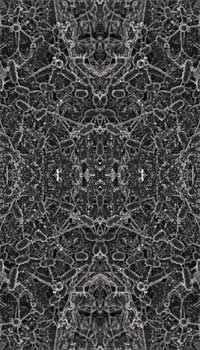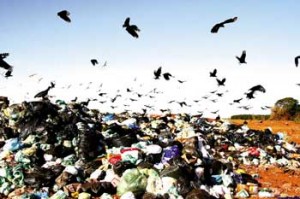
Estella Atekwana/Oklahoma State University Beneath the surface: filaments link Shewanella oneidensis bacteriaEstella Atekwana/Oklahoma State University
A sanitary landfill or a piece of land drenched in oil from an oil pipeline leak are far from being life-friendly environments from the human viewpoint. However, for certain bacteria, soil contaminated by these kinds of pollutants may be a feast, as they are able to use the waste that is rich in organic matter as an energy source. Indeed, this microbial activity may even be quite desirable because, when the bacteria eat, they degrade the organic compounds and help to clean up polluted areas. Carlos Alberto Mendonça, a Brazilian geophysicist, and collaborators in the United States and Europe believe one can find out when the bacteria are active without having to inspect the soil. In the last few years, they found indications that the bacterial repast leaves a web of electricity conducting material that is quite subtle, yet detectable with the aid of relatively simple equipment. If further experiments confirm the phenomenon, which the researchers have named biogeobattery, tracking the electric current may turn into a tool to show where the microorganisms are helping to eliminate soil contaminants and where the bacteria are unable to fully clean up the land.
The researchers presented a model that explains the functioning of these biogeobatteries in an article soon to be published in the journal JGR-Biogeosciences. Actually, this concept is an extension of a well established and studied geophysical phenomenon, the geobattery, according to Mendonça, a professor at the Astronomy, Geophysics and Atmospheric Sciences Institute at the University of São Paulo (IAG-USP). “This electrical anomaly is often linked to conductive minerals in the subsoil, in particular iron sulfide or copper sulfide,” he explains. “For this reason it has become an important indication for mineral prospecting, especially for copper mining.”
Geobatteries appear when water in the subsoil comes into contact with a mass of metal minerals extending mainly in a vertical direction (from the shallowest to the deepest level). In these circumstances, the more superficial portion of the metal mass comes into contact with a greater amount of oxygen in the air, whereas the deepest portion continues to be largely anoxic (oxygen free). The difference in the concentration of this chemical element facilitates transforming chemical energy into electric energy: it is the so-called redox (oxidation-reduction) reaction, in which one of the compounds transfers negatively charged electrical particles (electrons) to another. In the case of a metallic mineral, the region in contact with the air loses electrons (oxidizes) whereas the deeper region gains electrons (suffers reduction). The electron flow generates a current whose effect, electric potential, can be detected with a pair of electrodes and a voltmeter.
Until just a few years ago, identifying this type of anomaly provided an interesting clue about minerals in the soil. However, nothing was known about the possible link between this and the microscopic biodiversity of the soil. This started to change thanks to data from the Entressen sanitary landfill in southern France. In an article published in 2003 in Geophysical Research Letters, the team of André Revil – a researcher from the Colorado School of Mines in the United States and from the University of Savoy, in France, with which Mendonça collaborates – demonstrated the occurrence of electrical anomalies very similar to geobatteries in the Entressen landfill.
What was first observed in Entressen was later observed elsewhere: in the surroundings of a refinery in Berre, also in southern France, where a crude oil spill had taken place, and in old gasworks that used natural gas in Portadown, Northern Ireland, where the soil and the water table were contaminated with organic compounds after the gasworks was shut down. The electric potential detected was of hundreds of millivolts, about one third of what a common battery produces. This may not seem like much, “but the associated current is considerable,” Mendonça says.
In all these cases, it was natural to expect microorganisms to act on the organic molecules contaminating the soil. Indeed, in Berre, oil biodegradation was known to be occurring. If the electrical anomaly was present, perhaps it would not be overly bold to propose that microorganisms had something to do with it. “This is the major challenge, the major question we want to answer,” states Mendonça.
Indications that the group was moving in the right direction came from another study, published in 2007 in Geophysical Research Letters by the team of Yuri Gorby, from the J. Craig Venter Institute (JCVI) in the United States. Gorby and his colleagues found that the bacterium Shewanella oneidensis could produce filaments just 100 nanometers (millionths of a millimeter) thick that conducted electricity. According to this study, the filaments might function like electrical wires, through which the bacteria could transmit the electrons that were left over from their metabolism in the soil, where minerals could absorb them.

CELIO MESSIAS/AESanitary landfill: energy source for bacteria that degrade organic compoundsCELIO MESSIAS/AE
In their 2007 work, Gorby’s team went a step further. The researchers filled a column with damp sand to simulate a layer of soil in their lab. They then added microbes to the mixture and observed the outcome. Days later, they found that an electrical current was crossing the artificial soil from the lower level to the upper one. They also discovered that a web of filaments linked the bacteria. The group then proposed that this entanglement was what kept this type of microbial battery running. According to Mendonça, if this web of filaments reached a scale of size that was meters long, it would explain what had been observed in contaminated soil.
“To date, no one has managed to experimentally contest the 2007 study, but many microbiologists criticize it because they believe it is impossible that electron transmission among bacteria could reach a scale of meters,” explains the geophysicist from USP. “For them, there should be a loss of energy and the transmission should take place among just a few bacteria, at most.”
Mendonça and his colleagues, however, believe that the dissipation of energy may be far less strong – which would render feasible the notion that certain species of bacteria, such as Shewanella oneidensis, might be behind biogeobatteries. “Without this, it becomes very difficult to explain the electric signal that we have detected,” he says. The model developed by Mendonça’s team took its inspiration from the so-called bacterial fuel cells, which have already been heavily studied in laboratory settings to explain the operation of biogeobatteries. Like fuel cells, the polluted soil’s organic molecules could be working as fuel for the bacteria, which would then transfer electrons from one battery pole to the other. As in geobatteries, the electron flow would arise in the deeper, anoxic areas and move toward the surface, richer in oxygen. “Thus, one would have an entanglement of nanofilaments with electrical properties produced by this microbe community which would in a way electrify a substantial portion of the Earth,” compares Mendonça.
The group to which Mendonça belongs must now obtain more robust data to back its model. One possibility is to test their ideas in field studies. The team has two areas in mind: the site of an oil spill in the United States, and a landfill site the size of a city block and six meters deep, near the Pinheiros river, in São Paulo. “Waste is discarded in this landfill after the flotation and centrifugation are conducted to reduce the amount of pollutants in a segment of the river,” explains the researcher from USP. “Unfortunately, in this case, one thing gets cleaned up [the river] but another gets contaminated [the soil].”
If the group’s hypothesis is correct, it will be possible to identify a different electrical signature at different soil depths – redox reactions occurring in the deeper regions of the polluted area, with oxidation taking place further up, and all of this mediated by a web of interlinked microorganisms. “We have to see if it’s possible to check out this effect directly, because these areas often have a spatial complexity that can hinder the analysis,” Mendonça cautions.
If this experiment works, the detection of biogeobatteries in contaminated soil may become an indicator of the presence of favorable conditions for the natural degradation of pollutants. The lack of an electric current, on the other hand, would mean that, left to its own devices, nature would be incapable of decomposing the contaminant. “In this case, the contamination might last for centuries and direct intervention would be needed to solve the problem,” he states. It would suffice to stick electrodes in the ground to tell these two possibilities apart.
Mendonça reminds us that many researchers think that perhaps the electrified bacterial web is an ancient element of the biosphere, which arose more than two billion years ago, when the Earth’s atmosphere had less oxygen and microorganisms consumed the iron in the soil to generate energy and stay alive, and he adds: “It’s incredible to find a process that perhaps dates back to when the planet’s current atmosphere first appeared in something that is, so to speak, very modern, like pollutant-contaminated soil.”
The Project
Laboratory device to simulate fields of spontaneous potential in the geophysical profiling of wells (nº 06/06956-5); Type Regular Research Awards; Coordinator Carlos Alberto Mendonça – IAG/USP; Investment R$21,988.37 (FAPESP)
Scientific article
REVIL, A.; Mendonça, C. A. et al. Understanding biogeobatteries: where geophysics meets microbiology. JGR-Biogeosciences. Special issue. In press.